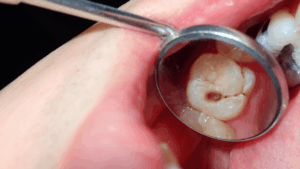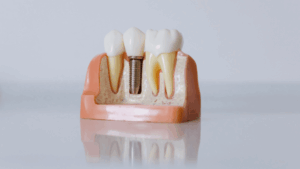Missing teeth have a negative impact on your smile, as well as affect your ability to chew, speak, and maintain good oral health. Many people also experience a loss of confidence due to the gap between the teeth. However, the good news is that bridge dentistry offers a practical and long-lasting solution for missing teeth replacement.
These days, modern dental bridges have become a trusted method for restoring smiles, especially when performed by skilled cosmetic dentists in Tacoma, Puyallup, Graham, and surrounding locations.
If you’re new to this concept and considering it as part of your restorative dental treatment, this blog will guide you through what a dental bridge is and help you understand the dental bridge procedure from start to finish. By the end of this blog, you’ll have the insight you need to make the best choice for your smile and confidence.
What Is a Bridge in Dentistry?
A dental bridge is a custom-made appliance designed to “bridge” the space created by one or more missing teeth. According to leading cosmetic dentistry experts in Graham, this procedure uses artificial teeth anchored by crowns on adjacent natural teeth or dental implants.
Key Benefits of Dental Bridges:
- Restore chewing and speaking ability
- Support facial structure and aesthetics
- Maintain alignment of surrounding teeth
- Prevent jaw joint issues and bone loss
Many people are confused about what exactly the bridge is in dentistry. To put it simply, a fixed dental restoration can be a way to restore form and function to your mouth.
What Is a Bridge Crown in Dentistry?
The role of the bridge crown is to support the dental bridge. These are crowns placed on two natural teeth or implants adjacent to each side of the missing space, holding the bridge securely in place. It’s the anchor of your bridge system. These crowns can be made of porcelain, metal, or zirconia, providing durability with a natural look. Combined, the dental crown and bridge function like your natural teeth.
This is the essential part of both restorative and cosmetic dental bridge treatments.
Types of Dental Bridges
Many types of dental bridges have been designed to fulfill the specific needs of patients. These types are:
1. Traditional Dental Bridges
- How it works: Involves placing crowns on both sides of the gap.
- Pros: Strong and aesthetically pleasing.
- Cons: Requires removal of some enamel from adjacent teeth.
2. Cantilever Bridges
- How it works: It is attached to only one supporting tooth.
- Pros: Option when only one adjacent tooth is available.
- Cons: Not suitable for areas under high chewing pressure.
3. Maryland Bonded Bridges
- How it works: Uses a metal or ceramic structure fixed to the back of adjacent teeth.
- Pros: Conservative and non-invasive.
- Cons: Less durable than other options.
4. Implant-Supported Bridges
- How it works: Uses implants instead of natural teeth as anchors.
- Pros: Long-lasting and strong.
- Cons: Higher cost of dental bridges and involves surgery.
The right type of dental bridge is chosen according to specific dental issues, oral conditions, budget, and long-term dental objectives.
The Role of a Bridge Dentist
A bridge dentist is the one who carries out the bridge dental procedure, whether it’s a prosthodontist or a skilled general dentist. At Meridian South Family Dentistry, we take pride in offering expert services through our dentists in Graham, Puyallup, Tacoma, and surrounding locations.
What to Expect During Consultation:
- Thorough dental examination
- Digital imaging or impressions
- Comparison of options: bridge vs implant, dental bridge vs dentures
- Customized treatment plan
Choose an experienced bridge dentist to ensure successful outcomes and long-term satisfaction. At Meridian South Family Dentistry, you’re connected with experienced professionals committed to delivering exceptional results and personalized care.
For more information, feel free to contact us at 253-847-4388.
Fixed Bridge for Teeth: A Reliable Solution
A fixed bridge is a form of dental restoration used to fill the space caused by one or more missing teeth. Artificial teeth (pontics) are used in fixed bridges and permanently bonded to crowns—called abutments—on adjacent natural teeth or implants. According to the leading cosmetic dentists in Graham, this secure attachment creates a stable and long-lasting solution that restores your bite and prevents teeth from shifting out of place.
Common Materials:
- Porcelain: Aesthetic, tooth-colored
- Metal: Durable and cost-effective
- Zirconia: Strong and aesthetic blend
How Long Do Dental Bridges Last?
When properly cared for, bridges can last 10 to 15 years or longer. Here are some tips to increase their life:
- Use a soft-bristled toothbrush
- Clean under the bridge with floss threaders
- Avoid chewing ice or hard candies
- Visit your dentist for regular cleanings
Fixed bridges are not like dentures; they stay in place and perform like natural teeth, making them a smart long-term tooth replacement option.
Benefits of Bridge Teeth
There are many advantages of opting for bridge teeth:
- Restores your ability to chew and speak
- Prevents teeth from shifting
- Preserves facial structure
- Offers a permanent, natural-looking solution
- More affordable than implants
The advantages of dental bridges include fewer visits compared to implants, no need for bone grafts, and a faster recovery time. It’s the best solution that strikes a balance between function and appearance.
Additionally, by utilizing materials like porcelain, the color of bridges can be easily matched to that of your natural teeth, making it an ideal solution recommended by cosmetic dentists in Graham, Puyallup, Tacoma, and neighboring communities.
Is Bridge Dentistry Right for You?
Bridge dentistry is the right choice for you if you:
- Have one or more missing teeth
- Have strong teeth or implants on either side of the gap
- Prefer a fixed solution over removable dentures
- Are not a candidate for implants due to medical or financial reasons
Here is a quick comparison of bridge teeth with other options:
| Feature | Bridge Teeth | Dental Implants | Dentures |
| Cost | Moderate | High | Low |
| Longevity | 10–15 years | 15–25 years | 5–8 years |
| Procedure | Non-surgical | Surgical | Non-surgical |
| Maintenance | Easy with daily care | Slightly more complex | Removable cleaning |
If bone loss or budget constraints are making it difficult for you to get implants, then a temporary dental bridge or a fixed bridge for teeth can provide an ideal solution. During the consultation, your dentist will assess and discuss with you whether you require a permanent or temporary bridge based on your specific condition.
Book Your Appointment Before the Summer Rush
Summer days are the best time to make your dental visit, but don’t wait, as appointment slots fill up fast!
At Meridian South Family Dentistry, we provide:
- Full-service dentistry in Puyallup, Tacoma, or surrounding locations
- Advanced prosthodontic treatments
- High-quality cosmetic dental bridge treatments
Our team uses our diligence to bring back your confident smile with expert care.
Final Thoughts
Bridge dentistry is a reliable and effective way to restore your smile and improve its functionality. It is essential to understand all aspects of bridge teeth, from the basics of what a bridge is in dentistry to comparing bridges vs. implants and gaining a comprehensive understanding of options such as bridge crowns, fixed bridges, and temporary bridges. Having all this knowledge helps you to make the right decision.
From evaluating your oral health to selecting the most suitable bridge material, our team at Meridian South Family Dentistry ensures personalized solutions and dedicated care. Proudly serving patients in Graham, Puyallup, Tacoma, and surrounding locations, our team of cosmetic dentists and general dentists is dedicated to your long-term dental health and wellness.
Take the next step. Call us today at 253-847-4388 and schedule your consultation for a healthier, more confident you!





